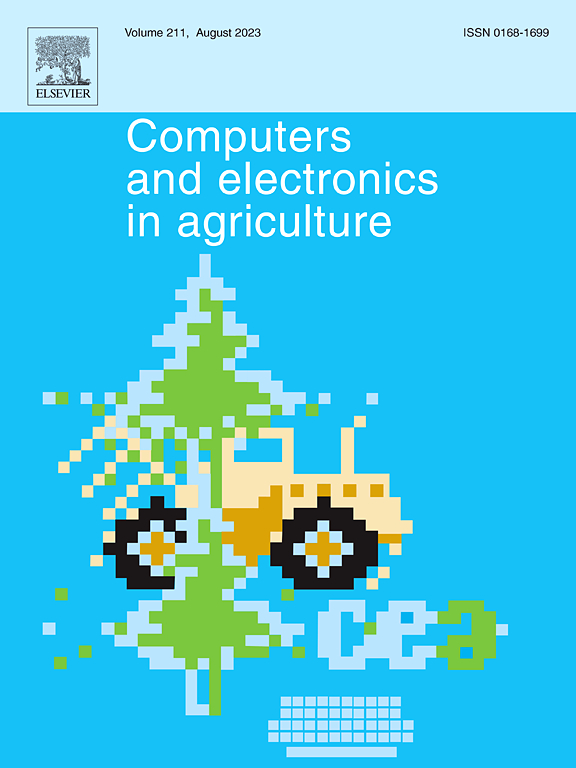A comparison of proximal and remote optical sensor platforms for N status estimation in winter wheat
IF 8.9
1区 农林科学
Q1 AGRICULTURE, MULTIDISCIPLINARY
引用次数: 0
Abstract
Monitoring crop N status by means of proximal and remote sensing data can help enhancing N use efficiency at various farm scales. This study compares five optical sensor platforms, commonly used in practice and research, based on their usability and accuracy in measuring crop N status at field level. The data were gathered in 2019 in two sites in northeast Switzerland that were cropped with winter wheat (Triticum aestivum). The optical sensor platforms employed included a Sentinel-2 satellite, two different unmanned aircraft systems (UAS fixed-wing and quadcopter), a tractor-mounted system, and a handheld field spectrometer. We used a power regression to compare the measured crop N uptake with spectral vegetation indices computed from the different sensors. The reported normalized difference red-edge (NDRE) index values were distributed in a broad range from 0.17 to 0.74, with the Sentinel-2 satellite records in the higher part of the range (0.59–0.74) and those of the handheld spectrometer in the low range (0.17–0.29). The study’s key finding was the information collected was significantly different across the five sensing platforms, in terms absolute values from the sensors. However, the correlations between NDRE values from all sensors and the measured N uptake were comparably robust, with r > 0.8 a root mean square error ranging from 29 to 37 kg N/ha. Furthermore, the N application maps produced for the satellite and UAS platforms showed that the best compromise between detailed spatial resolution and matching of the working width of the machinery used was achieved by resampling the UAS-based maps at 10 m resolution with the calculation used in this study. We concluded that sensor-based N status assessment across different sensing levels can support the improvement of N use efficiency by allowing a more precise management of in-field variability, with the precondition of having a good calibration for climatic location and variety. However, factors such as the degree of detail needed to capture in-field variability while matching the working width should be evaluated for each specific case.
近端与远端光学传感器平台对冬小麦氮素状态估测的比较
利用近端和遥感数据监测作物氮素状况有助于提高不同农业规模下氮素利用效率。本研究比较了实践和研究中常用的5种光学传感器平台在田间水平测量作物氮状态的可用性和准确性。这些数据是2019年在瑞士东北部种植冬小麦(Triticum aestivum)的两个地点收集的。采用的光学传感器平台包括一颗Sentinel-2卫星,两种不同的无人机系统(UAS固定翼和四轴飞行器),一个拖拉机安装系统和一个手持式现场光谱仪。我们使用幂回归将测量的作物氮吸收与从不同传感器计算的光谱植被指数进行比较。报告的归一化差红边指数(NDRE)分布在0.17 ~ 0.74的较宽范围内,其中Sentinel-2卫星记录在较高范围内(0.59 ~ 0.74),手持式光谱仪记录在较低范围内(0.17 ~ 0.29)。该研究的主要发现是,就传感器的绝对值而言,五个传感平台收集的信息存在显著差异。然而,所有传感器的NDRE值与测量的N吸收量之间的相关性相对较强,r >;0.8,均方根误差29 ~ 37 kg N/ha。此外,为卫星和UAS平台制作的N个应用地图表明,在详细空间分辨率和所使用机器的工作宽度匹配之间的最佳折衷是通过使用本研究中使用的计算方法,以10米分辨率重新采样基于UAS的地图。结果表明,在对气候位置和品种进行良好校准的前提下,基于传感器的不同感知水平的氮素状态评估可以通过更精确地管理田间变异来支持氮素利用效率的提高。然而,在匹配工作宽度的同时,诸如捕获现场变异性所需的细节程度等因素应针对每个具体情况进行评估。
本文章由计算机程序翻译,如有差异,请以英文原文为准。
求助全文
约1分钟内获得全文
求助全文
来源期刊

Computers and Electronics in Agriculture
工程技术-计算机:跨学科应用
CiteScore
15.30
自引率
14.50%
发文量
800
审稿时长
62 days
期刊介绍:
Computers and Electronics in Agriculture provides international coverage of advancements in computer hardware, software, electronic instrumentation, and control systems applied to agricultural challenges. Encompassing agronomy, horticulture, forestry, aquaculture, and animal farming, the journal publishes original papers, reviews, and applications notes. It explores the use of computers and electronics in plant or animal agricultural production, covering topics like agricultural soils, water, pests, controlled environments, and waste. The scope extends to on-farm post-harvest operations and relevant technologies, including artificial intelligence, sensors, machine vision, robotics, networking, and simulation modeling. Its companion journal, Smart Agricultural Technology, continues the focus on smart applications in production agriculture.
 求助内容:
求助内容: 应助结果提醒方式:
应助结果提醒方式:


